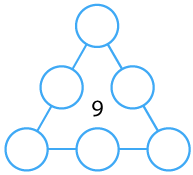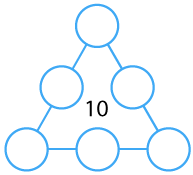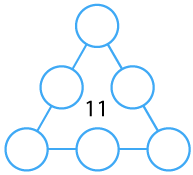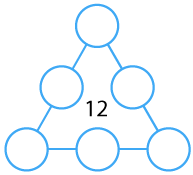Copyright © University of Cambridge. All rights reserved.
'Number Round Up' printed from https://nrich.maths.org/
Show menu
Why do this problem?
This problem is an interesting context in which children can practise addition and subtraction. It can be solved in many different ways and the sample approaches offer a basis for discussion of possible different methods. You might spend a couple of lessons on this activity.
Possible approach
You could introduce this challenge by displaying the interactivity on the board. Begin by dragging one of the totals into the centre of the triangle and then start to drag a few of the numbers into any places. Ask the children to talk about what they notice. Some may mention the numbers used but direct them to look at totals along each "side" if it doesn't come up naturally. This will mean they understand the set-up and you can then leave them to try the problem itself.
Try not to direct learners too much at this stage but make sure they understand that they can use any resources or equipment that they might find helpful. If available, you could invite learners to use the interactivity on a tablet or computer in pairs. (You might want to have these sheets of blank triangles available should anyone request them.)
Once you feel that most children have made progress and understand the problem well (this does not necessarily mean that they have found all the solutions), show children the ways that the three different pupils began working on the task. Suggest to the class that when they've finished or can't make any further progress, they should look at the three approaches used by different children. You might like to print off the second page of the printable sheet for children to read through - this can be found at the top of the main problem page. Pose the question, "What might each do next? Can you take each of their starting ideas and develop them into a solution?". It might be appropriate to read through each method as a whole class before giving pairs time to work on each one. Alternatively, you may prefer to allocate a particular starting point to each pair.
Allow at least fifteen minutes for a final discussion. Invite some pairs to explain how the three different methods might be continued. You may find that some members of the class used completely different approaches when they worked on the task to begin with, so ask them to share their methods too. You can then facilitate a discussion about the advantages and disadvantages of each. Which way would they choose to use if they were presented with a similar task in the future? Why?
(You may find that conversations arise about the number of different solutions for each total. Encourage children to articulate what they think is the same and what is different in this context. They might not all agree!)
Key questions
Why did you put that number there?
Tell me about how you found that solution.
Is there only one solution?
Tell me about this approach. What do you think they were doing?
How do you think this will help to solve the problem?
What do you think they would have done next?
Possible support
Learners might request a range of different resources to help them tackle this challenge, for example numbered counters, mini-whiteboards, number lines, tablets to use the interactivity... Try not to pre-empt their requests by placing equipment out on tables at the start, but do make sure these kind of resources are easily accessible to the children, should they want to use them, and do your best to accommodate any requests which you hadn't anticipated!



